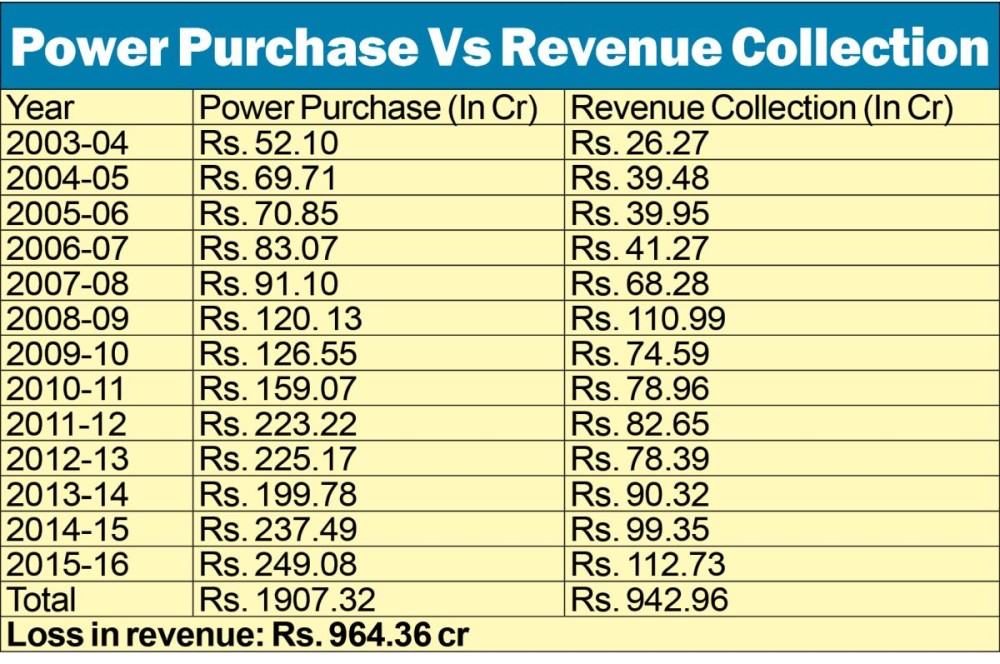
Going digital touted to be a means to recovery
Imkong Walling
Dimapur | March 5
Crumbling infrastructure, short supply and pilferage defines the energy sector in Nagaland state. Lurking underneath though is a revenue segment that could fairly be termed as more problematic than the comprehensible physical mess. While it has escaped the public eye, the investment-earning gap in the state’s energy sector is showing no sign of narrowing causing the exchequer tens of crores annually.
Power pilferage, metre tampering, under billing and unrealised bills from consumers, regarded as the major problems, have hit revenue collection hard. Data maintained by the Department of Power, Nagaland indicate that the state has lost around a 1000cr over the past 10-15 years as a result.
As per the data, annual revenue collection rarely hit the 50 percent mark against the cost of purchase. Energy demand on the other hand is growing at the rate of 10 percent per annum.
During the year 2015-16, the state spent a record Rs. 249cr on power purchase while the revenue collected in return stood at only Rs. 112cr. The year 2007-08 was the only instance when returns crossed the 70 percent mark. That particular year ended with a total revenue collection of Rs. 68cr against a total purchase cost of Rs. 91cr.
The burgeoning expenses on energy purchase year after year without corresponding return has given way to a bureaucratic stalemate between the state government and the Department of Power, Nagaland. As per department insiders, the government accuses the department of under-performing while the latter’s alibi is one of under-funding.
Further, a disgruntled government is reported to have tightened the purse strings on the state’s energy sector virtually suspending it to a perpetual state of dormancy.
Straightening the revenue segment is held to hold the key to breaking the status quo between the two entities, while affecting a revival in the energy sector.
Going digital and righting billing woes
Meanwhile, going digital is touted as one of the means to streamlining an erratic revenue segment. The proposed reform initiative banks on how effectively the Power department implements a project funded under the Union Government’s Restructured Accelerated Power Development Reform Programme (R-APDRP). The project comes with a package to digitise the existing energy accounting and billing system with reducing loss as the primary objective.
“The basic idea is to streamline billing and stricter energy accounting,” said a department official of the ongoing project.
The gamut of the project, being implemented phase-wise, includes digitising the entire revenue collection apparatus and GIS mapping of assets (poles, transformers, lines), while doing away with the existing Legacy Computer Billing System
It includes fitting data sensors for monitoring energy flow from an assigned central station. This aspect of the project is already functional in select revenue/distribution sub-divisions. The official explained, “The quantum of energy supplied or consumed can now be assessed transformer-wise and the revenue realised from one transformer has to match with that of the energy consumed via the given transformer.”
The department would then be able pinpoint imbalance in the consumption-revenue ratio at any given location or transformer.
The process of moving to the new system was started in March 2016 in two distribution/revenue sub-divisions in Dimapur. During the early phase of “data migration from the old system to the new,” the official said that there were technical snags, which resulted in an unprecedented incidence of wrong billing.
The project seeks to bring a slew of changes to the consumers, including online bill payment, which was launched in October 2016, spot billing, toll free number for registering connection problems and automated payment kiosks. As per the department, when the toll free number goes functional, a consumer has to provide the consumer number using which field personnel will locate the place without the consumer having to give directions over phone. For billing complaints consumers will have no choice but to use the traditional method of visiting a given area’s sub-divisional office.
“Hopefully, once the new billing system stabilises revenue generation will improve and energy consumption can be monitored more strictly.”






